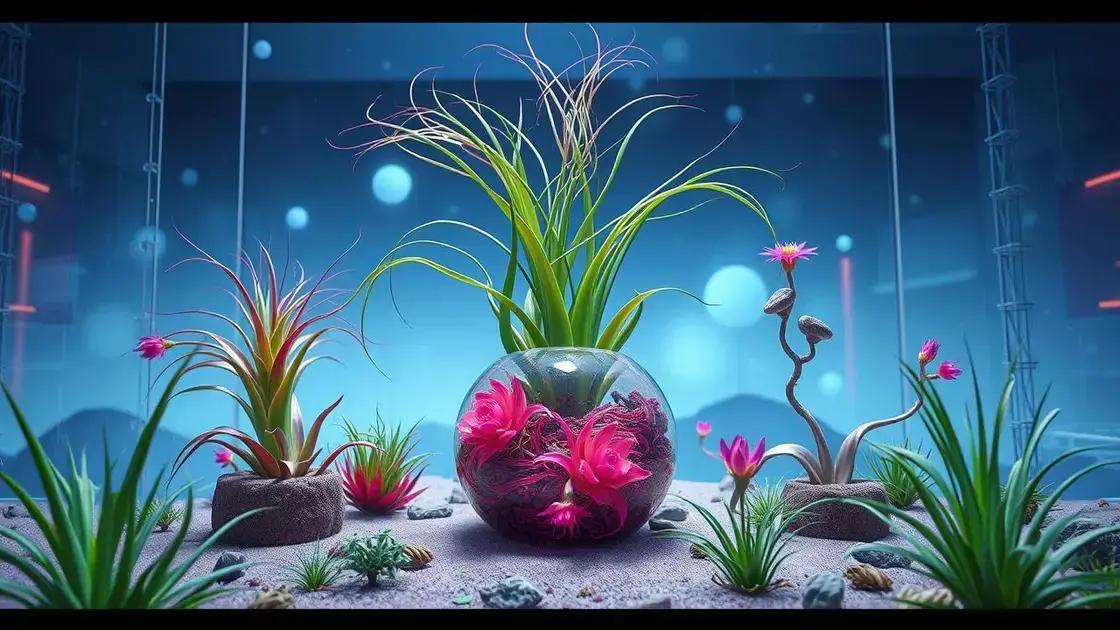How to Care for Air Plants Inside: 5 Essential Tips for Success
Imagine having a lush, green oasis right in your living room. **How to care for air plants inside** can transform your space into a vibrant retreat. These fascinating plants require specific light and watering conditions to truly flourish. Dive into the essentials of air plant care: discover optimal growing techniques, the best routines for maintaining moisture, and how to create a beautiful indoor display with these unique plants.
Table of Contents
ToggleUnderstanding air plant needs for indoor growth
Understanding air plant needs for indoor growth is essential for creating a thriving environment. These unique plants, also known as tillandsias, adapt to various conditions, but they do have specific requirements to flourish indoors.
- Light: Air plants need bright, indirect light. Too much direct sunlight can scorch their leaves. Instead, a spot near a window with filtered light is ideal.
- Water: Watering is crucial for air plant health. A good rule is to soak the plants in water for about 20-30 minutes once a week. If the air is particularly dry, misting a few times a week can help maintain humidity.
- Temperature: Air plants prefer temperatures between 60°F and 80°F (15°C to 27°C). Avoid exposing them to cold drafts or extreme temperature changes.
While caring for these plants, it is also important to ensure proper air circulation around them. This can help prevent mold and bacteria, which are common issues when air plants are in a closed container.
Optimal indoor conditions for air plants
Creating the right environment
The right setup can significantly influence the health of your air plants. Here are essential factors:
- Location: Place them in areas that receive some natural light without direct exposure.
- Humidity: Keeping humidity levels around 50% or higher encourages growth and prevents drying out.
Consider grouping them with other indoor plants to increase the humidity naturally. You can also place them in terrariums, which can create a mini ecosystem.
Common mistakes to avoid
Learn from others
Many new air plant owners struggle with a few common issues:
- Overwatering: Plants should never sit in water; this can cause rot.
- Neglecting their need for light: A common misconception is that they survive low light conditions.
- Using the wrong type of container: Ensure any holders allow for air circulation and drainage.
Exploring indoor gardening techniques can help enhance your understanding of how to effectively care for air plants. By minimizing mistakes and learning from the experiences of others, you can cultivate healthy air plants that thrive indoors.
Essential watering techniques for air plants

Essential watering techniques for air plants are vital for their health and longevity. Proper hydration supports their unique physiology and ensures they thrive indoors.
Air plants, or tillandsias, absorb water and nutrients through their leaves. Unlike most plants, they don’t grow in soil, so how you water them is crucial.
Effective watering methods
There are several techniques you can utilize to effectively water your air plants:
- Soaking: Dunk the plants in room temperature water for 20-30 minutes.
- Misting: Use a spray bottle to mist the leaves lightly, especially in dry environments.
- Dripping: You can drip water onto the leaves, ensuring every leaf receives moisture.
Each method has its advantages, depending on your plant’s specific needs and the humidity levels in your home.
When to water your air plants
Determining when to water is just as crucial as how you water. Watch for these signs:
- If the leaves feel dry to the touch.
- When their color appears faded or dull.
- About once a week for soaking; adjust for humidity levels.
During warmer months, you may need to increase watering frequency, as heat can dry out the plants faster.
Common mistakes
While watering air plants may seem simple, there are pitfalls to avoid:
- Overwatering can lead to rot, especially if the plants sit in water.
- Underwatering can cause leaves to curl or dry out.
- Not allowing adequate air circulation post-watering can promote mold growth.
For more insights, consider exploring indoor gardening techniques that can further enhance your plant care practices.
Best light conditions for thriving air plants
Best light conditions for thriving air plants are crucial for their health and growth. Air plants, or tillandsias, rely on light not only for photosynthesis but also for maintaining vibrant colors and strong structures.
Optimal lighting conditions
To ensure your air plants thrive, it’s essential to provide the right amount and type of light:
- Bright, indirect sunlight: Position them near windows that receive filtered sunlight.
- Artificial lighting: Use grow lights if natural light is insufficient, especially in winter.
- Avoid direct sunlight: Prolonged exposure can scorch the leaves and damage the plant.
Signs of inadequate light
Being attentive to your air plants allows you to identify potential lighting issues:
- Leaves may become elongated and leggy as they stretch for light.
- Colors may fade, indicating they are not receiving enough light.
- Some species may start to curl or dry out due to insufficient exposure.
Seasonal adjustments
Light conditions can change seasonally, affecting your air plants:
- Spring and summer: Typically, air plants will need more light during these months as days are longer.
- Fall and winter: It may be necessary to reposition your plants closer to windows or invest in artificial lights.
Regularly assess your air plants to ensure they adapt to seasonal changes effectively. For further tips on creating the perfect environment, consider exploring indoor gardening techniques that provide additional insights.
In conclusion
Caring for air plants inside can be a rewarding experience when you understand their unique needs. By mastering watering techniques, providing the best light conditions, and closely monitoring their health, you can create a thriving indoor oasis. Remember, each plant is different, so adapt your care methods based on their specific requirements. For additional tips on enhancing your indoor garden, don’t hesitate to explore more resources. Happy planting!

